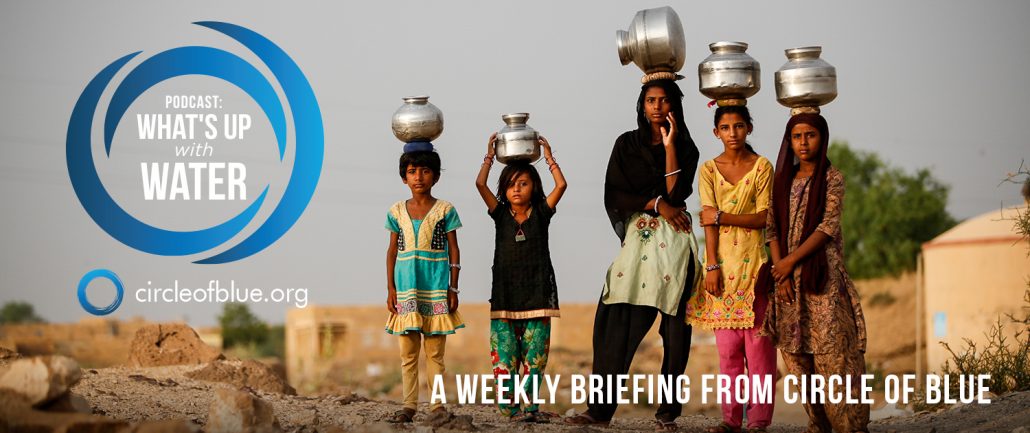
Transcripts
What’s Up With Water for March 19, 2018
I’m Eileen Wray-McCann, for Circle of Blue, and here’s What’s up with Water, a condensation of the world’s water news.
As World Water Day approaches on March 22, the United Nations and the World Bank are calling for a “fundamental shift” in global water management. Their panel of international leaders declared that water infrastructure must be doubled over the next five years if the UN’s Sustainable Development Goals are to be met. The panel reports that currently 40% of people on the planet are affected by water scarcity. Over two billion drink unsafe water and more than twice that have inadequate sanitation. This disproportionally burdens women and girls in terms of health, work and education. The report says only about 20% of wastewater is treated before it is returned to the environment and water-related disasters are happening more often and with greater consequences. The panel calls for evidence-based policies and new approaches at all levels of government and across communities, companies and research organizations.
For more on this report and World Water Day coverage, visit circleofblue.org
The Trump administration has, for the first time, blamed Russia for cyberattacks on American and European nuclear power pants and water and electric systems. Intelligence officials have long been aware of the activity. They see the hacks as Moscow demonstrating its ability to access crucial elements of America’s infrastructure. In 2015 and 2016, Russia disrupted the Ukrainian electrical grid, leaving over 200,000 people without power.
Bankwatch, the global financial monitoring network, says that pristine rivers in the Balkans are under increased threat by hydropower projects funded by multilateral development banks. Bankwatch reports that since 2005, the European Bank for Reconstruction and Development, the European Investment Bank and the World Bank Group have supported some 82 hydropower projects across southeast Europe, with nearly half in protected areas such as national parks and high biodiversity zones.
The report adds that commercial banks, notably in Austria and Italy, are also important financiers of hydropower projects, which include plants and dams that starve local streams of water. Residents of affected areas have protested the damage to their communities, and Bankwatch warns that the renewable energy sector could face a backlash if destructive projects continue to be funded. More than 2,100 dams are being planned or have been built in Southeast Europe since 2005. Not all the designs will move forward. Over a thousand planned hydropower projects have yet to be funded. Bankwatch refers to the 2017 drought in the Balkans as proof that climate change makes dependence on hydropower risky, both in terms of energy production and the environment.
China is changing its Ministry of Environmental Protection into the broader Ministry for Ecological Environment. China’s parliament said the new ministry will take on responsibilities from other ministries, in an effort to coordinate efforts for air, land, and water. China is grappling with the environmental impact of three decades of unbridled economic growth, in addition to the increasing effects of climate change. The new Ministry will take over the multi-decade South-to-North water transfer project, a massive infrastructure development to ease droughts in the north of China by channeling river water from the flood-prone south.
In Afrin, Syria, water has been cut off for more than a week after Turkish troops seized control of the city’s main dam and a water pumping station. Residents have been forced to use untreated water from borehole wells and face the risk of both scarcity and disease. The situation is expected to worsen as Turkey’s army continues an offensive to drive a Kurdish militia out of the area.
The World Health Organization says it will review potential risks of plastics in drinking water after a new study suggests that up to 90% of bottled water contains plastic particles. Scientists at the State University of New York analyzed bottled water from leading brands and various countries, and found an average of 325 plastic particles for every litre of water. The scientists had previously found high levels of microplastics in tap water as well, but said the concentrations in bottled water were roughly twice as high as in tap water. The most common type of plastic found was polypropylene, the kind used to make bottle caps. The particles were identified using a special dye which sticks to plastics.
The American Beverage Association said it stood by the safety of its bottled water and noted that the research on microplastics is in its early stages. The university study has not been published in a journal and has not had a scientific peer review. The World Health Organization says that although there is presently no evidence on the health effects of microplastics, it is aware of the developing concern and will work toward a more thorough risk evaluation.
And that’s What’s Up With Water…We’d like to share what’s up where you are – Tweet us with your water news: @circleofblue #whatsupwithwater.
Eileen Wray-McCann is a writer, director and narrator who co-founded Circle of Blue. During her 13 years at Interlochen Public Radio, a National Public Radio affiliate in Northern Michigan, Eileen produced and hosted regional and national programming. She’s won Telly Awards for her scriptwriting and documentary work, and her work with Circle of Blue follows many years of independent multimedia journalistic projects and a life-long love of the Great Lakes. She holds a BA and MA radio and television from the University of Detroit. Eileen is currently moonlighting as an audio archivist and enjoys traveling through time via sound.



